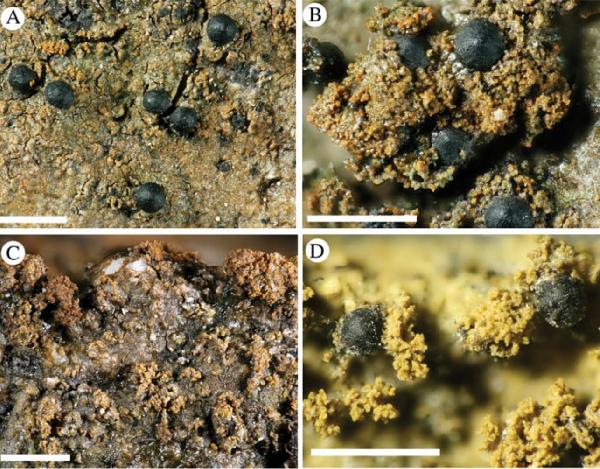Porina collina Orange, Palice & Klepsland
Lichenologist, 52: 272, 2020.
Synonyms:
Distribution:
Description: Thallus crustose, episubstratic, 20-125 μm thick, ecorticate, greenish orange-brown, fading in the herbarium, uneven, continuous or with few small cracks, covered with concolorous, more or less isidioid, finely granular structures which at first arise singly but later form irregular, convex, soon confluent patches, the granules poorly-defined, incompletely corticate, 10-40 μm wide under the stereomicroscope, 30-150(-250) x 30-125(-150) μm under the compound microscope, rarely gathered in densely coralloid units, easily disintegrating in water. Perithecia black, globose, 0.22-0.42 mm across, immersed in thallus at base, with an inconspicuous ostiolar region. Involucrellum absent; exciple more or less surrounding the whole perithecium, the outer part dark purplish brown, K+ grey to dark grey-brown to dark greenish grey, the inner part yellowish, K+ intensifying (Porina yellow pigment); paraphyses mostly simple, thread-like. Asci 8-spored, cylindrical-clavate, thin-walled throughout, functionally unitunicate, I-, K/I-, the apex rounded and without a a refractive ring. Ascospores 3-septate, hyaline, narrowly ellipsoid, 24-43 x 5.5-6 μm. Photobiont trentepohlioid. Spot tests: thallus K-, C-, KC-, P-, UV-. Chemistry: thallus without lichen substances.Note: a recently-described silicicolous species growing on steeply inclined or slightly overhanging, often rain-sheltered rock faces in shaded-humid sites, mostly in forests and along rivers. It is currently known from a few localities in the Czech Republic, Great Britain and Norway, but it may be more widespread. For further details see Orange & al. (2020). To be looked for in Italy.
Growth form: Crustose
Substrata: rocks
Photobiont: Trentepohlia
Reproductive strategy: mainly asexual, by isidia, or isidia-like structures (e.g. schizidia)

Predictive model

Source: Orange A, Palice Z, Klepsland J. A new isidiate saxicolous species of Porina (Ascomycota, Ostropales, Porinaceae). The Lichenologist. 2020;52(4):267-277. doi:10.1017/S0024282920000183
. Porina collina. A & B, holotype, with isidia and perithecia. C, Orange 24121, sterile thallus with isidia. D,
Klepsland JK14-L214 - Scale bar: 1 mm
Growth form: Crustose
Substrata: rocks
Photobiont: Trentepohlia
Reproductive strategy: mainly asexual, by isidia, or isidia-like structures (e.g. schizidia)

Predictive model


